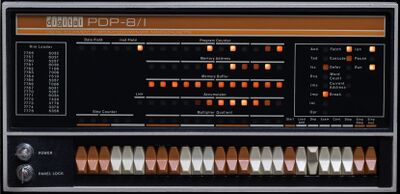Difference between revisions of "PDP-8/I"
m (→Images: +Another image) |
(+implementation details) |
||
| Line 22: | Line 22: | ||
}} | }} | ||
| − | The '''PDP-8/I''' was introduced in 1968 as the successor to the [[PDP-8]]. It was constructed out of [[Transistor-transistor logic|TTL]] [[integrated circuit|ICs]] on M-class [[FLIP CHIP]]s | + | The '''PDP-8/I''' was introduced in 1968 as the successor to the [[PDP-8]]. It was constructed out of [[Transistor-transistor logic|TTL]] [[integrated circuit|ICs]] on M-class [[FLIP CHIP]]s - mostly early [[DEC card form factor|standard-length single-height]] (width) ones, with a few dual-height. It was the first [[Digital Equipment Corporation|DEC]] computer to be built using ICs. |
Options included: | Options included: | ||
| Line 42: | Line 42: | ||
[[Image:PDP-8'I HoppeLighted.jpg|left|thumb|400px|PDP-8/I of the Göttingen Computer Club in Göttingen, Germany]] | [[Image:PDP-8'I HoppeLighted.jpg|left|thumb|400px|PDP-8/I of the Göttingen Computer Club in Göttingen, Germany]] | ||
| + | |||
| + | <br clear=all> | ||
[[:File:PDP-8'I ComputerCabinettGöttingen.jpg|Another image]] | [[:File:PDP-8'I ComputerCabinettGöttingen.jpg|Another image]] | ||
| Line 47: | Line 49: | ||
==External links== | ==External links== | ||
| − | * [http://www.bitsavers.org/pdf/dec/pdp8i PDP-8/I] - Original PDP-8/I documents | + | * [http://www.bitsavers.org/pdf/dec/pdp8/pdp8i PDP-8/I] - Original PDP-8/I documents |
{{Nav PDP-8}} | {{Nav PDP-8}} | ||
[[Category: PDP-8s]] | [[Category: PDP-8s]] | ||
Revision as of 15:34, 19 April 2022
| PDP-8/I | |
 PDP-8/I front panel | |
| Year Introduced: | 1968 |
|---|---|
| Form Factor: | minicomputer |
| Word Size: | 12 |
| Logic Type: | TTL |
| Design Type: | clocked random logic |
| Clock Speed: | 333KHz |
| Memory Speed: | 1.5 μseconds |
| Physical Address Size: | 32KW (requires optional MC8/I) |
| Virtual Address Size: | 4KW |
| Memory Management: | bank selection, CPU mode |
| Bus Architecture: | negative I/O bus |
| Operating System: | TSS/8. Disk Monitor System |
| Predecessor(s): | PDP-8 |
| Successor(s): | PDP-8/E |
The PDP-8/I was introduced in 1968 as the successor to the PDP-8. It was constructed out of TTL ICs on M-class FLIP CHIPs - mostly early standard-length single-height (width) ones, with a few dual-height. It was the first DEC computer to be built using ICs.
Options included:
- KA8/IB Positive I/O Bus Interface, to allow use of newer PDP-8 devices
- DW08A Negative I/O Bus Conversion Option (on systems with a KA8/I, allows use of older PDP-8 devices)
- DW08B Positive I/O Bus Conversion Option (on systems without a KA8/I, allows use of newer PDP-8 devices)
- DW8-E OMNIBUS Interface (converts the positive bus of an 8/I)
- MC8/I Memory Extension Control, bank switching needed to support more than 4K words of memory
- MP8/I Memory Parity
- KE8/I Extended Arithmetic Element, which supported hardware integer multiplication and division, one-bit double-word shifts, and normalization
- KT8/I Time Sharing Hardware Modification, which allowed the computer to operate in either Executive Mode or User Mode
It could perform an addition to the accumulator in 3.0 μseconds, and a 12 by 12 bit multiplication with 24 bit result in 6.0 μseconds, using the math extension hardware.
The MC-8/I had three 3-bit registers: the Instruction Field and associated Instruction Buffer, and Data Field, which could be loaded either manually from the front panel, or under program control (by the Change Instruction Field - something of a misnomer, as it was actually the IB which was loaded - and Change Data Field instructions). The IB contents were loaded into the IF by a jump or subroutine call.
Images
External links
- PDP-8/I - Original PDP-8/I documents
| v • d • e PDP-8 Computers, Software and Peripherals |
|---|
| PDP-8s: PDP-5 • PDP-8 • LINC-8 • PDP-8/S • PDP-8/I • PDP-8/L • PDP-12 • PDP-8/E • PDP-8/F • PDP-8/M • PDP-8/A
Workstations: VT78 Also: PDP-8 family • PDP-8 architecture • PDP-8 Memory Extension units |
